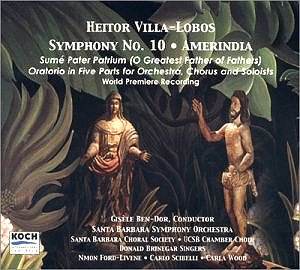With CPO currently about halfway (at least numerically)
through their cycle of Villa-Lobos’s twelve symphonies, this release
from Koch of the largest, the choral-and-orchestral Tenth, is most timely.
Written to mark the 400th anniversary of the founding of
the Brasilian capital, São Paolo in 1552, it was first performed
in Paris five years later under the composer’s baton in an apparently
typical ramshackle performance. That it was not well received is unsurprising,
even if the performance had been as well drilled as that on this new
recording. It is an occasional work out of its time, in annotator Steven
Ledbetter’s words "a kind of musical history lesson" that
cannot have had much relevance to a Parisian audience in 1957. Written
in a style more redolent of film music, as a novelty it must have seemed
desperately anachronistic when compared to other new music of the day.
The work’s structure cannot have aided its appreciation,
being as much an oratorio (which can go under the title of Sumé
Pater Patrum, ‘O Greatest Father of Fathers’) as a symphony, neither
form in vogue critically. The symphony centres on the huge 24-minute
fourth movement De Beata Virgine Dei Mater Maria, a kind of suite
in four sections functioning like a work-within-a work. For the most
part the music sets extracts from a huge poem by Father José
de Anchieta depicting the arrival of the Portuguese, their joy at discovering
the teeming continent, expressed in praise of the Virgin Mary and their
rejection of Protestantism, expressed as an image of an Infernal Dragon
representing "death-bringing Calvin". Like so much of Villa-Lobos’
orchestral output, the music is richly illustrative but here the crucial
dramatic event—the concluding "Infernal Dragon" section—seems
underplayed by the very richness of the palette he used.
For all its weaknesses structurally and dramatically,
the Tenth Symphony is a fascinating piece, full of remarkable music
instantly recognisable as Villa-Lobos. The opening allegro, The Earth
and its Creatures, is perhaps too long for its material and as with
many of his symphonies, symphonic development is only fitfully present.
The succeeding War Cry is wistful and gentle, a "lament
for the lost tranquillity and isolation of the countryside" to
quote Ledbetter again rather than a call to arms of the native populace
to resist the Portuguese. (And as a descendant of the conquerors, whether
or not there is any truth in any of the composer’s outrageous claims
to Amerindian origin, Villa-Lobos always presented the arrival of the
Europeans as a good thing; the Indians’ rather different perspective
would not, I suspect, ever have occurred to him.) It is the first to
feature voices, and has more vigorous central sections that sound straight
out of the Bachianas Brasileiras, as does the third movement,
a celebratory scherzo subtitled Iurupichuna (a species of small,
magical monkey). The fifth and final movement, Glory in Heavens and
Peace on Earth, is more fully choral (like the fourth) and continues
to set extracts from Anchieta’s poem. Its unquestioning affirmation
may strike many listeners as a touch hollow, but it is hard to see how
else this large work could reasonably have concluded. I feel bound to
comment also that the choral writing does not contain the same subtlety
as do the works of Hyperion’s wonderful CD of Villa-Lobos Sacred Choral
Music (CDA 66638).
Gisèle Ben-Dor, who has previous conducted some
revelatory recordings for the same label of Ginastera (3-7149-2) and
Revueltas (3-7421-2), secures a committed and full-blooded account of
this teeming and problematic score. (She also provides a highly informative
note on the difficulties the music presents to a conductor.) The three
soloists and the amalgamated choruses sing with more energy than refinement
(entirely appropriate for this repertoire, however) ably supported by
the Santa Barbara Symphony Orchestra who are the real stars of the show.
Never a disc or a work to win competitions or great plaudits, perhaps,
that should not detract from what is a splendid achievement all round.
Self-recommending to lovers of this composer (I count myself for one),
it is certainly worth exploring by those who know him only for the Bachianas
Brasileiras.
Guy Rickards


